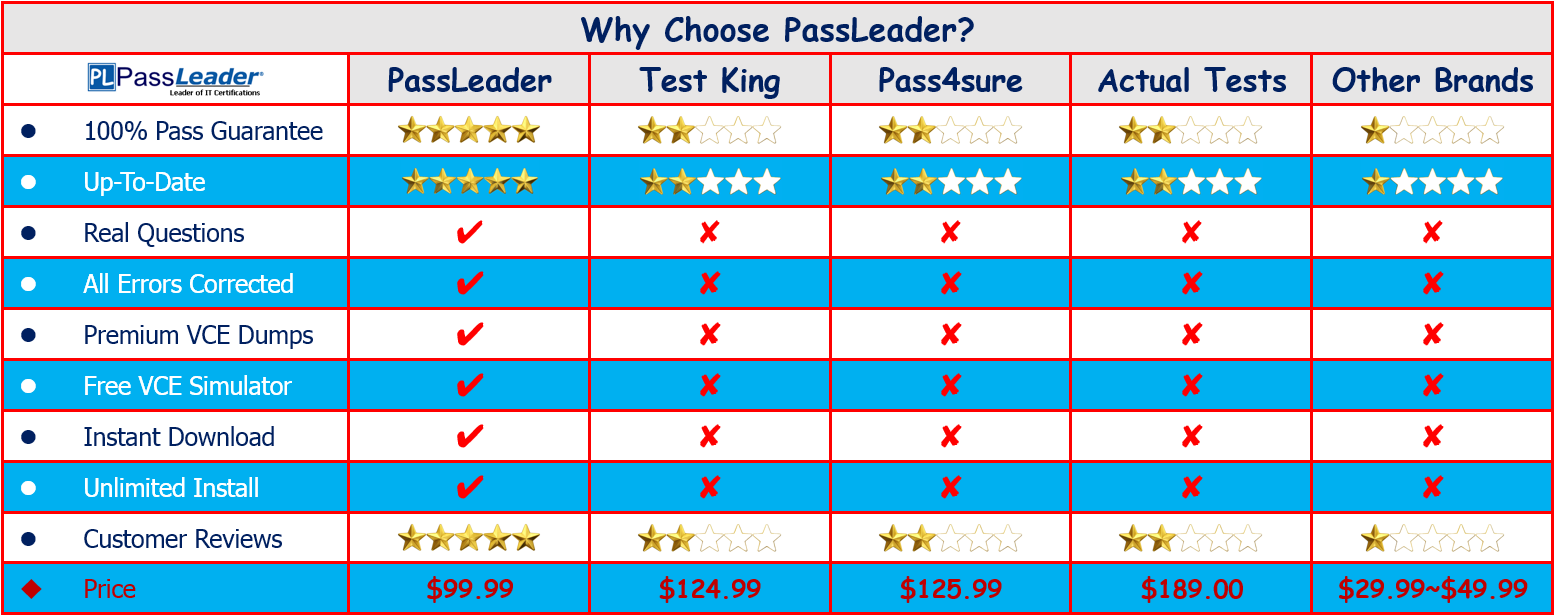How To Pass The New 70-466 Exam? PassLeader now is offering the newest and 100 percent pass ensure 70-466 186q braindumps, the latest updated 70-466 186q exam questions are the most accurate exam dumps with all the new changed questions, which will help you passing 70-466 exam easily and quickly. Now visit the our site passleader.com and get the valid 70-466 186q exam vce and pdf practice test and FREE VCE PLAYER!
keywords: 70-466 exam,70-466 exam dumps,70-466 186q exam questions,70-466 pdf dumps,70-466 vce dumps,70-466 186q practice test,70-466 vce file,Implementing Data Models and Reports with Microsoft SQL Server 2014 Exam
QUESTION 41
You are developing a SQL Server Analysis Services (SSAS) cube. The cube contains several dimensions, a local measure group, and a linked measure group. Both measure groups use MOLAP partitions. You need to write-enable one of the linked measure group partitions to support Microsoft Excel 2010 PivotTable What-If Analysis. What should you do before the partition can be write- enabled?
A. Implement the cube as a local cube.
B. Implement the linked measure group as a local measure group.
C. Ensure that the measure group measures only use semiadditive aggregation functions.
D. Ensure that the measure group measures only use nonadditive aggregation functions.
QUESTION 42
You are developing a BI Semantic Model (BISM) that will be used to analyze complex budgeting and forecast data sourced from a financia database. The model will be deployed to a server with 32 GB of RAM. The source data, located in a SQL Server data warehouse, is currently using 10 terabytes of disk space and is doubling in size every three months. The model will be queried by staff in the accounting department by using Microsoft Excel 2010. You need to ensure the highest query performance and scalability for the accounting department queries. Which project type should you choose?
A. PowerPivot workbook
B. tabular project that uses the In-Memory query mode
C. multidimensional project
D. tabular project that uses the DirectQuery query mode
Answer: C
QUESTION 43
You are developing a SQL Server Analysis Services (SSAS) tabular database. To maximize performance, queries must be resolved only by using cache. You need to configure the appropriate query mode. Which query mode should you select?
A. DirectQuery with In-Memory
B. In-Memory
C. In-Memory with DirectQuery
D. DirectQuery
Answer: B
QUESTION 44
You are developing a SQL Server Analysis Services (SSAS) tabular project. A model contains tables and columns that must not be visible to the user. The columns and tables cannot be removed because they are used in calculations. You need to hide the tables and columns. What should you do?
A. Right-click the applicable tables and columns and select the Hide option.
B. In the Properties window for the applicable tables and columns, set the Enabled property to False.
C. In the Properties window for the applicable tables and columns, set the Visible property to True.
D. Right-click the applicable tables and columns and select the Hide from Client Tools option.
Answer: D
QUESTION 45
You are developing a SQL Server Analysis Services (SSAS) tabular project. A column named City must be added to the table named Customer. The column will be used in the definition of a hierarchy. The City column exists in the Geography table that is related to the Customer table. You need to add the City column to the Customer table. How should you write the calculation?
A. =RELATEDTABLE(Geography)
B. =RELATED(Geography[City])
C. =Geography[City]
D. City:=Geography[City]
E. City:=RELATED(Geography[City])
F. City:=RELATEDTABLE(Geography)
Answer: E
QUESTION 46
You are developing a SQL Server Analysis Services (SSAS) tabular project that will be used by the finance, sales, and marketing teams. The sales team reports that the model is too complex and difficult to use. The sales team does not need any information other than sales related resources in the tabular model. The finance and marketing teams need to see all the resources in the tabular model. You need to implement a solution that meets the needs of the sales team while minimizing development and administrative effort. What should you do?
A. Create a separate tabular model for each team.
B. Hide the non-sales columns from the client tools.
C. Create a security role for the sales team.
D. Create a perspective for the sales team.
Answer: D
QUESTION 47
You are developing a SQL Server PowerPivot workbook that sources data from a SQL Azure database. The PowerPivot model includes a single table named FactSales that consists of four columns named Year, Country, Product, and Revenue. The model includes the following two measures.
Sales:=SUM(FactSales[Revenue;)
Sales %:=;Sales] / CALCULATE([Sales], ALL(FactSales))
In Microsoft Excel 2010 you create the following PivotTable report. 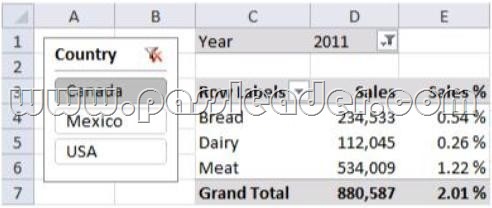
Users report that the Sales % measure computes an incorrect ratio. The measure should meet a requirement to compute a ratio over all visible sales values defined by the query filters. The Grand Total value for the Sales % measure should equal 100%. You need to fix the Sales ?o measure to meet the requirement. Which Data Analysis Expressions (DAX) expression should you use?
A. =[Sales] / CALCULATE([Sales])
B. =[sales] / [Sales](ALLSELECTED(FactSales))
C. =[sales] / CALCULATE([Sales], VALUES(FactSales[Year]), VALUES(FactSales[Country]))
D. =[sales] / [Sales](ALLEXCEPT(FactSales, FactSales[Year]))
Answer: B
QUESTION 48
You are developing a SQL Server Analysis Services (SSAS) tabular project. You need to grant the minimum permissions necessary to enable users to query data in a data model. Which role permission should you use?
A. Explorer
B. Process
C. Administrator
D. select
E. Browser
F. Read
Answer: F
QUESTION 49
You are developing a SQL Server Analysis Services (SSAS) tabular project. The model includes a table named DimEmployee. The table contains employee details, including the sales territory for each employee. The table also defines a column named EmployeeAlias which contains the Active Directory Domain Services (AD DS) domain and logon name for each employee. You create a role named Employees. You need to configure the Employees roles so that users can query only sales orders for their respective sales territory. What should you do?
A. Add a row filter that implements only the USERNAME function.
B. Add a row filter that implements the LOOKUPVALUE and USERNAME functions.
C. Add a row filter that implements only the CUSTOMDATA function.
D. Add a row filter that implements the LOOKUPVALUE and CUSTOMDATA functions.
Answer: B
QUESTION 50
You are developing a Microsoft SQL Analysis Services (SSAS) multidimensional project. A fact table named FactHouseSales has a measure column named Area. All values in the column are stored in square feet. Users must be able to analyze the area in different units. You create a table named AreaUnit. Each row in the table consists of the unit name and a square feet conversion factor value. You need to implement the area conversion in the project. What should you do?
A. Use role playing dimensions.
B. Use the Business Intelligence Wizard to define dimension intelligence.
C. Add a measure that uses the Count aggregate function to an existing measure group.
D. Add a measure that uses the DistinctCount aggregate function to an existing measure group.
E. Add a measure that uses the LastNonEmpty aggregate function.
Use a regular relationship between the time dimension and the measure group.
F. Add a measure group that has one measure that uses the DistinctCount aggregate function.
G. Add a calculated measure based on an expression that counts members filtered by the Exists and NonEmpty functions.
H. Add a hidden measure that uses the Sum aggregate function.
Add a calculated measure aggregating the measure along the time dimension.
I. Create several dimensions.
Add each dimension to the cube.
J. Create a dimension.
Then add a cube dimension and link it several times to the measure group.
K. Create a dimension.
Create regular relationships between the cube dimension and the measure group.
Configure the relationships to use different dimension attributes.
L. Create a dimension with one attribute hierarchy.
Set the XsAggregatable property to False and then set the DefaultMember property.
Use a regular relationship between the dimension and measure group.
M. Create a dimension with one attribute hierarchy.
Set the IsAggregatable property to False and then set the DefaultMember property.
Use a many-to-many relationship to link the dimension to the measure group.
N. Create a dimension with one attribute hierarchy.
Set the ValueColumn property, set the IsAggregatable property to False, and then set the DefaultMember property.
Configure the cube dimension so that it does not have a relationship with the measure group.
Add a calculated measure that uses the MemberValue attribute property.
O. Create a new named calculation in the data source view to calculate a rolling sum.
Add a measure that uses the Max aggregate function based on the named calculation.
Answer: N
QUESTION 51
You are creating a SQL Server Analysis Services (SSAS) multidimensional database. Users need a time dimension for:
Dates
Delivery dates
Ship dates
You need to implement the minimum number of required SSAS objects. What should you do?
A. Use role playing dimensions.
B. Use the Business Intelligence Wizard to define dimension intelligence.
C. Add a measure that uses the Count aggregate function to an existing measure group.
D. Add a measure that uses the DistinctCount aggregate function to an existing measure group.
E. Add a measure that uses the LastNonEmpty aggregate function.
Use a regular relationship between the time dimension and the measure group.
F. Add a measure group that has one measure that uses the DistinctCount aggregate function.
G. Add a calculated measure based on an expression that counts members filtered by the Exists and NonEmpty functions.
H. Add a hidden measure that uses the Sum aggregate function.
Add a calculated measure aggregating the measure along the time dimension.
I. Create several dimensions.
Add each dimension to the cube.
J. Create a dimension.
Then add a cube dimension and link it several times to the measure group.
K. Create a dimension.
Create regular relationships between the cube dimension and the measure group.
Configure the relationships to use different dimension attributes.
L. Create a dimension with one attribute hierarchy.
Set the XsAggregatable property to False and then set the DefaultMember property.
Use a regular relationship between the dimension and measure group.
M. Create a dimension with one attribute hierarchy.
Set the IsAggregatable property to False and then set the DefaultMember property.
Use a many-to-many relationship to link the dimension to the measure group.
N. Create a dimension with one attribute hierarchy.
Set the ValueColumn property, set the IsAggregatable property to False, and then set the DefaultMember property.
Configure the cube dimension so that it does not have a relationship with the measure group.
Add a calculated measure that uses the MemberValue attribute property.
O. Create a new named calculation in the data source view to calculate a rolling sum.
Add a measure that uses the Max aggregate function based on the named calculation.
Answer: A
QUESTION 52
You are designing a SQL Server Reporting Services (SSRS) report based on a SQL Server Analysis Services (SSAS) cube. The cube is used to measure sales growth by salesperson. The cube contains a Key Performance Indicator (KPI) to show if a salesperson’s sales are off target, slightly off target, or on target. You need to add a report item that visually displays the KPI status value as a red, yellow, or green flag. Which report item should you add?
A. a Sparkline
B. a Gauge that uses the Radial type
C. an Indicator
D. a Gauge that uses the Linear type
E. a Data Bar
Answer: C
QUESTION 53
You install SQL Server Reporting Services (SSRS). You need to back up a copy of the symmetric key. Which command should you run?
A. rskeymgmt -d
B. rskeymgmt -i.
C. rskeymgmt -e -f %temp%\rs.key -p Password1
D. rskeymgmt -a -f %temp%\rs.key -p Password1
Answer: C
QUESTION 54
You are developing a SQL Server Reporting Services (SSRS) report. The report includes a dataset with fields named Year, MonthNumber, and InvCount. The report includes a table that displays the inventory count per year, as shown in the following diagram. 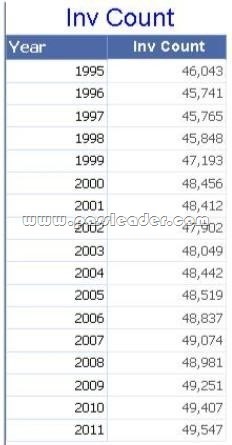
You need to modify the table to include a graphical item displaying the inventory count trend to the right of the Inv Count column. What should you do?
A. Add an Indicator item to a new column on the right of the Inv Count column.
Select the Directional Indicator type and then select the MonthNumber field for Value.
B. Add a Sparkline item to a new column on the right of the Inv Count column.
Then select the InvCount field for Values and the MonthNumber field for Category Groups.
C. Add an Indicator item to a new column on the right of the Inv Count column.
Select the Directional Indicator type and then assign the MonthNumber field to the Start property.
D. Add a Sparkline item to a new column on the right of the Inv Count column.
Then select the InvCount field for Values and the MonthNumber field for Series Groups.
E. Add a text box to a new column on the right of the Inv Count column.
Then use a Go to report action to link to a separate report showing the monthly trend.
Answer: B
http://www.passleader.com/70-466.html
QUESTION 55
Drag and Drop Questions
You are developing a SQL Server Reporting Services (SSRS) report that sources data from a SQL Azure database and a SQL Server Analysis Services (SSAS) cube. The cube contains a date dimension and other dimensions. The report design includes two report parameters named StartDate and FinishDate as shown in the following diagram. 
The Data Type property of the parameters is set to Date/Time. The Data Type property of the parameters is set to Date/Time. You need to create the dataset based on the SSAS cube. You also need to ensure that the dataset is filtered by the existing report parameters. Which three actions should you perform in sequence? (To answer, move the appropriate actions from the list of actions to the answer area and arrange them in the correct order.) 
Answer: 
QUESTION 56
Drag and Drop Questions
You are planning the installation of PowerPivot for SharePoint. You install SharePoint Server 2010 Enterprise Edition with Service Pack 1. You need to install the PowerPivot for SharePoint instance. Then you need to configure the Default Account username used to provision shared services in the SharePoint farm. Which three actions should you perform in sequence? (To answer, move the appropriate actions from the list of actions to the answer area and arrange them in the correct order.) 
Answer: 
QUESTION 57
You have a server that has SQL Server 2012 installed. You need to identify which parallel execution plans are running in serial. Which tool should you use?
A. Data Profile Viewer
B. Database Engine Tuning Advisor
C. Performance Monitor
D. Extended Events
Answer: D
QUESTION 58
You have a database named database1. Database developers report that there are many deadlocks. You need to implement a solution to monitor the deadlocks. The solution must meet the following requirements:
– Support real-time monitoring.
– Be enabled and disabled easily.
– Support querying of the monitored data.
What should you implement? More than one answer choice may achieve the goal. Select the BEST answer.
A. an Extended Events session
B. a SQL Server Profiler template
C. log errors by using trace flag 1204
D. log errors by using trace flag 1222
Answer: A
QUESTION 59
You are developing a multidimensional project that includes a dimension named Organization. The dimension is based on the DimOrganization table in the data warehouse. The following diagram illustrates the table design. 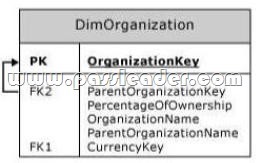
The Organization dimension includes a parent-child hierarchy named Organizations. The dimension includes the following dimension attributes:
— Organization, which is a key attribute
— Organizations, which defines the parent-child hierarchy
— Currency Code, which is a regular attribute
When users browse the dimension, three hierarchies are visible to them. You need to ensure that the Organization hierarchy is not visible to users. What should you do?
A. Set the AttributeHierarchyDisplayFolder property to Null for the Organization attribute.
B. Delete the Organization attribute.
C. Set the AttributeHierarchyEnabled property to False for the Organization attribute.
D. Set the AttributeHierarchyVisible property to False for the Organization attribute.
Answer: D
QUESTION 60
You are conducting a design review of a multidimensional project. In the geography dimension, all non-key attributes relate directly to the key attribute. The underlying data of the geography dimension supports relationships between attributes. You need to increase query and dimension processing performance. What should you do?
A. For the geography dimension, set the ProcessingMode property to LazyAggregations
B. For the dimension attributes of the geography dimension, define appropriate attribute relationships.
C. For the geography dimension, set the ProcessingPriority property to 1.
D. For the dimension attributes of the geography dimension, set the GroupingBehavior property to EncourageGrouping.
Answer: B
QUESTION 61
Drag and Drop Question
You have a cube named Cube1 that contains the sales data for your company. You plan to build a report based on the cube. You need to write an MDX expression that returns the total sales from the first month of the 2009 fiscal year and the total sales from the same period of the 2008 fiscal year. Which code segments should you insert at line 03 and line 05? To answer, drag the appropriate code segments to the correct lines. Each code segments may be used once, more than once, or not at all. You may need to drag the split bar between panes or scroll to view content. 
Answer: 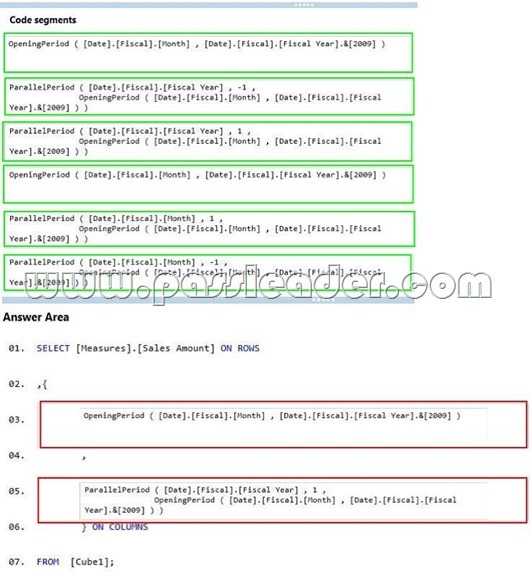
QUESTION 62
Drag and Drop Questions
You are developing reports based on the SQL Server Analysis Services (SSAS) cube named ProcessedOrders. A Multidimensional Expressions (MDX) query must include a query-scoped calculated member, which computes average sales per order item. The query must also return the set of three states in a query-scoped named set named East Coast Customers. You need to define the calculations in an MDX query to meet the requirements. Which four MDX segments should you insert in sequence before a SELECT statement? (To answer, move the appropriate actions from the list of actions to the answer area and arrange them in the correct order.) 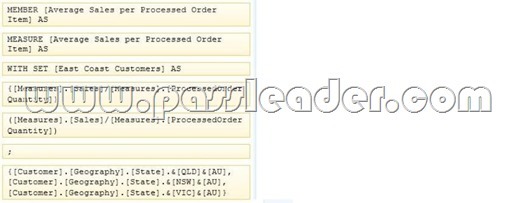
Answer: 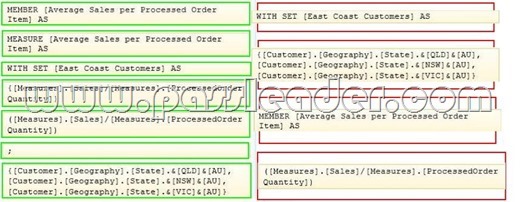
QUESTION 63
You are developing a BI Semantic Model (BISM) that will be used to analyze complex budgeting and forecast data sourced from a financial database. The model will be deployed to a server with 28 GB of RAM. The source data, located in a SQL Server data warehouse, is currently using 15 terabytes of disk space and is doubling in size every month. The model will be queried by staff in the accounting department by using Microsoft Excel 2010. You need to ensure the highest query performance and scalability for the accounting department queries. Which project type should you choose?
A. tabular project that uses the In-Memory query mode
B. tabular project that uses the DirectQuery query mode
C. multidimensional project
D. PowerPivot workbook deployed to SharePoint
Answer: C
QUESTION 64
You are developing a BI Semantic Model (BISM) that retrieves data from several sources including a SQL Azure database and an OData data feed. The model will be deployed to a server with significantly more memory than the total size of the source data. You have the data feed URL, which you will use when developing the model in SQL Server Data Tools (SSDT). The model must meet the following requirements:
– Maximize performance
– Data latency of up to one month is acceptable
You need to choose a project type and a data access mode to meet the requirements. What should you do?
A. Select the tabular project type and use the In-Memory query mode.
B. Select the multidimensional project type and use the MOLAP storage mode.
C. Select the tabular project type and use the DirectQuery query mode.
D. Select the multidimensional project type and use the ROLAP storage mode.
Answer: A
QUESTION 65
You are developing a SQL Server Analysis Services (SSAS) cube. The cube contains several dimensions, a local measure group, and a linked measure group. Both measure groups use MOLAP partitions. You need to write-enable one of the linked measure group partitions to support Microsoft Excel 2010 PivotTable What-If Analysis. What should you do before the partition can be write- enabled?
A. Implement the linked measure group as a local measure group.
B. Implement the local measure group as a linked measure group.
C. Set the Type property of the partition’s measure group to Forecast.
D. Set the StorageMode property of the linked measure group to Rolap.
Answer: A
QUESTION 66
Hotspot Question
You are developing a SQL Server Analysis Services (SSAS) cube. You are writing the following Multidimensional Expressions (MDX) statement for use by a calculated measure. The measure computes the sales amount for the same time period of the previous year. (Line numbers are included for reference only.) 
You need to complete the MDX statement. Which MDX function should you use in line 03? To answer, select the appropriate MDX function in the functions list. 
Answer: 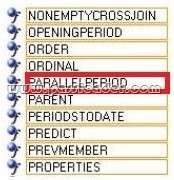
QUESTION 67
Drag and Drop Questions
You are developing a SQL Server Analysis Services (S5AS) cube. You need to add a calculated member to the Customer dimension to evaluate the sum of values for France and Germany. Which expression should you use? (To answer, drag the appropriate expression to the answer area.) 
Answer: 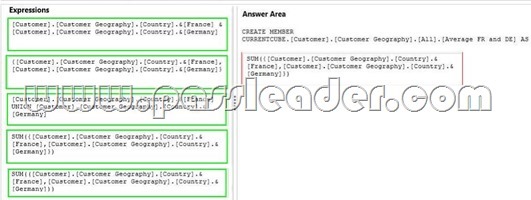
QUESTION 68
Hotspot Questions
You are developing a SQL Server Analysis Services (SSAS) cube for the accounts department. You create a measure group named Exchange Rate that consists of measures pertaining to currency exchange rates. One of the measures in this group is named Average Rate and it will be used to report the average currency exchange rate over time. Currently the AggregationFunction property for the Average Rate measure is set to Sum. You need to ensure that Average Rate measure reports the average of the currency exchange rate over time. Which value should you select for the AggregationFunction property for the Average Rate measure? To answer, select the appropriate setting in the answer area. 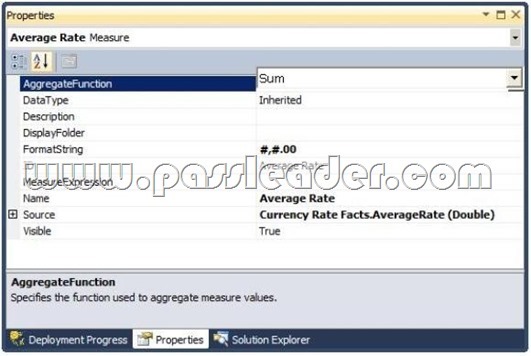
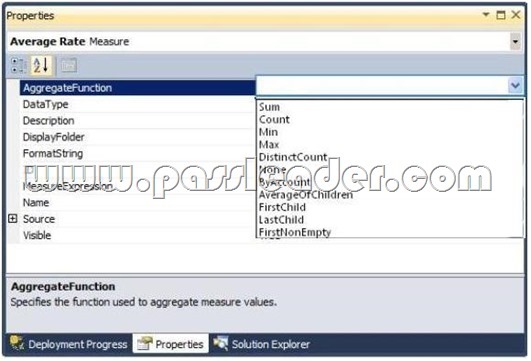
Answer: 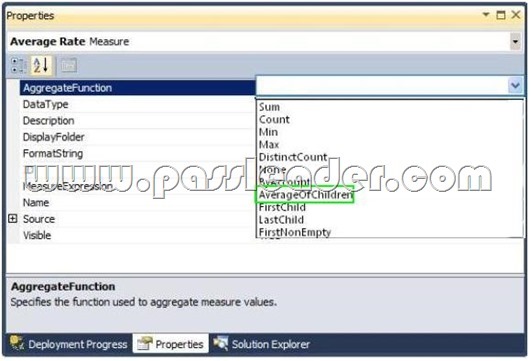
QUESTION 69
You are developing a SQL Server Analysis Services (SSAS) cube for the sales department at your company. The sales department requires the following set of metrics:
– Unique count of customers
– Unique count of products sold
– Sum of sales
You need to ensure that the cube meets the requirements while optimizing query response time. What should you do? (Each answer presents a complete solution. Choose all that apply.)
A. Place the measures in a single measure group.
B. Place the distinct count measures in separate measure groups.
C. Use the additive measure group functions.
D. Use the semiadditive measure group functions.
E. Use the Count and Sum measure aggregation functions.
F. Use the Distinct Count and Sum measure aggregation functions.
Answer: BF
QUESTION 70
Drag and Drop Questions
You are using Multidimensional Expressions (MDX) to query a SQL Server Analysis Services (SSAS) cube. You need to compute the aggregate value of the 10 most-ordered produces in the Product Categories hierarchy. The Product level is the lowest in the hierarchy. Which functions should you use to complete the MDX query? (To answer, drag the appropriate functions from the list of functions to the correct locations in the answer area.) 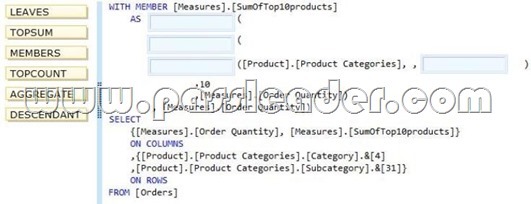
Answer: 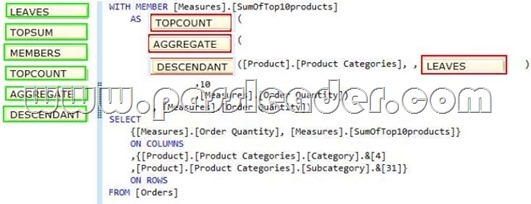
http://www.passleader.com/70-466.html
